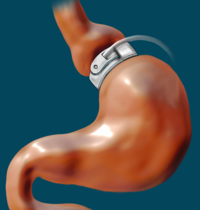
Photo from wikipedia
Background and Aims: Unsatisfactory weight loss after gastric bypass or sleeve gastrectomy in super-obese patients (body mass index > 50) is a growing concern. Biliopancreatic diversion with duodenal switch results in greater… Click to show full abstract
Background and Aims: Unsatisfactory weight loss after gastric bypass or sleeve gastrectomy in super-obese patients (body mass index > 50) is a growing concern. Biliopancreatic diversion with duodenal switch results in greater weight loss, but is technically challenging to perform, especially as a laparoscopic procedure (Lap-DS). The aim of this study was to compare perioperative outcomes of Lap-DS and the corresponding open procedure (O-DS) in Sweden. Material and Methods: The data source was a nationwide cohort from the Scandinavian Obesity Surgery Registry and 317 biliopancreatic diversion with duodenal switch patients (mean body mass index = 56.7 ± 6.6 kg/m2, 38.4 ± 10.2 years, and 57% females) were analyzed. Follow-up at 30 days was complete in 98% of patients. Results: The 53 Lap-DS patients were younger than the 264 patients undergoing O-DS (35.0 vs 39.1 years, p = 0.01). Operative time was 163 ± 38 min for lap-DS and 150 ± 31 min for O-DS, p = 0.01, with less bleeding in Lap-DS (94 vs 216 mL, p < 0.001). There was one conversion to open surgery. Patients undergoing Lap-DS had a shorter length of stay than O-DS, 3.3 versus 6.6 days, p = 0.02. No significant differences in overall complications within 30 days were seen (12% and 17%, respectively). Interestingly, the two leaks in Lap-DS were located at the entero-enteric anastomosis, while three out of four leaks in O-DS occurred at the top of the gastric tube. Conclusion: Lap-DS can be performed by dedicated bariatric surgeons as a single-stage procedure. The use of laparoscopic approach halved the length of stay, without increasing the risk for complications significantly. Any difference in long-term weight result is pending.
Journal Title: Scandinavian Journal of Surgery
Year Published: 2017
Link to full text (if available)
Share on Social Media: Sign Up to like & get
recommendations!